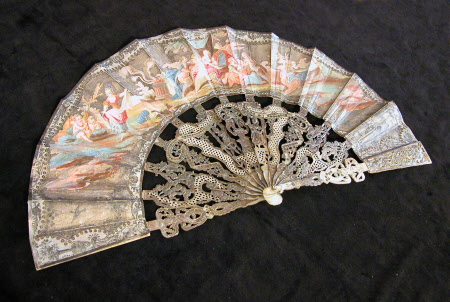Fan
Category
Costume
Date
1760 - 1780
Materials
Parchment, mother-of-pearl, sequin and applied silver
Measurements
33 mm (Width); 255 mm (Length)
Order this imageCollection
Ickworth, Suffolk
NT 852846
Caption
A delicately painted scene of a woman disturbed at her toilette by a male admirer decorates this 18th-century French fan. Romantic and flirtatious themes set within pastoral landscapes were popular subjects for fans, inspired by the paintings of French Rococo artists, such as François Boucher (1703–70). Here, the couple are surrounded by symbols of love, including tiny cupids and burning embers. The theme extends to the carved mother-of-pearl sticks decorated with a dancing couple surrounded by cupids and garlands of flowers. On the reverse, a couple sit contentedly in front of a cottage, suggesting marital union. Throughout the 18th century, fans were a highly desirable fashionable accessory for women of all classes, and the craft of fan making flourished in Europe. This fan is said to have been a present from the French king Louis XV (1710–74) to his granddaughter-in-law Marie Antoinette (1755–93). It was collected by Geraldine Georgiana Mary Anson, Marchioness of Bristol (1834–1927), who amassed an outstanding collection and was elected to the Worshipful Company of Fan Makers. Emma Slocombe
Summary
Fan. Leaf of parchment painted with a pastoral scene. Mother-of-pearl sticks, decorated with applied silver and sequins, in figures and garlands. Reverse with pastoral scene. French, C18. Believed to be a present from the French king Louis XV (1710–74) to his granddaughter-in-law Marie Antoinette (1755–93). It was collected by Geraldine Georgiana Mary Anson, Marchioness of Bristol (1834–1927) who bought the fan at Christies 1900.
Provenance
Part of the Bristol Collection. Acquired by the National Trust in 1956 under the auspices of the National Land Fund, later the National Heritage Memorial Fund.
References
Antrobus and Slocombe 2025: Helen Antrobus and Emma Slocombe, 100 Things to Wear: Fashion from the collections of the National Trust, National Trust 2025, pp. 78-79.

